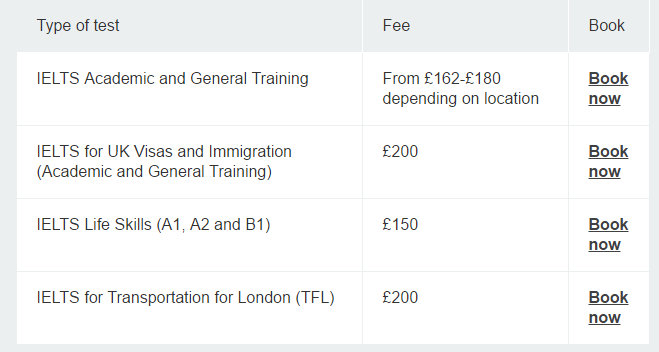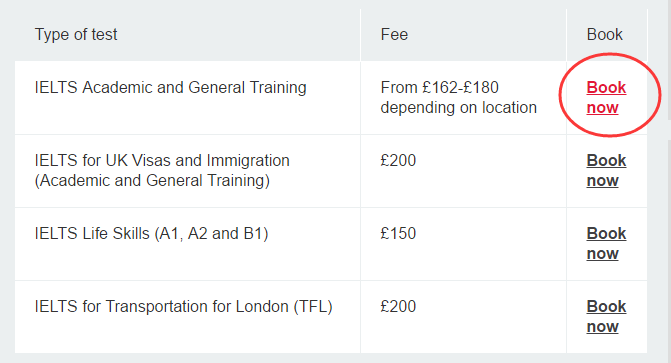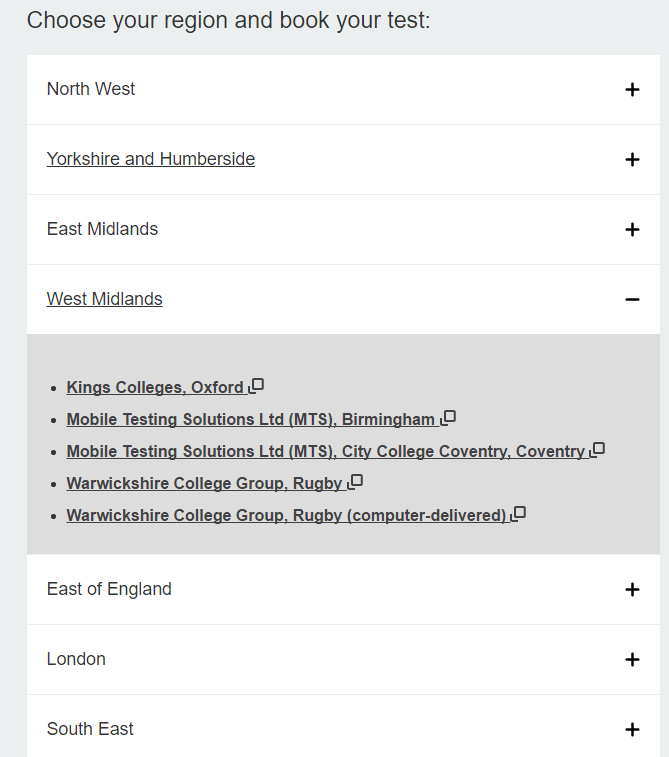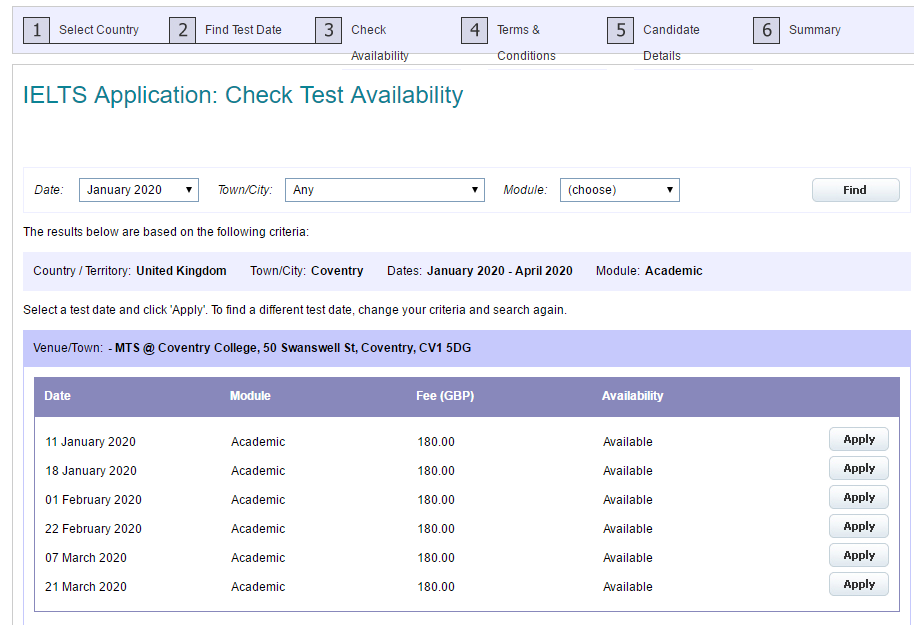C6.14 Taking IELTS in the UK¶
How to Take the IELTS Test in the UK?
There are four types of IELTS tests. Most international students take either the first type, IELTS Academic, or the fourth type, IELTS for UK Visas and Immigration (UKVI). Many students mistakenly book the wrong type of IELTS test, so I remind you to check carefully when registering to avoid errors. The four types of IELTS tests are as follows:
IELTS Academic and General Training
The Academic test is for those wishing to study at the undergraduate or postgraduate level worldwide. The General Training test is suitable for studying below degree level or working in an English-speaking country.
In other words: IELTS Academic is an English language test for students planning to study in the UK or other English-medium countries/regions. It is required for direct applications to undergraduate, postgraduate, or doctoral programs in the UK. I remind you that if you are applying directly for a degree program, you need to take this test and meet the university’s language requirements. Most UK undergraduate programs require an IELTS score of 6.0, postgraduate programs 6.5, while some universities or majors require 7.0 or higher. Additionally, some universities may require an additional internal language test alongside the IELTS score.
The General Training test is for candidates not applying for degree-level studies—such as those going to the UK for work or immigration.
IELTS for UK Visas and Immigration (Academic and General Training) (UKVI)
IELTS UKVI (Academic and General Training) and IELTS Life Skills are Secure English Language Tests (SELT) approved by the UK Home Office for UK visa applications.
I remind you: The UKVI IELTS test is specifically for students applying for UK language courses or foundation programs. If you take the first type (IELTS Academic) and do not meet the required score, you cannot use it to apply for UK language or foundation courses. To study a language or foundation program in the UK, you must take the UKVI IELTS test.
IELTS Life Skills (A1, A2 and B1)This test assesses your speaking and listening skills, and is required for family visas, indefinite leave to remain, or citizenship applications.
IELTS for Transportation for London (TfL)If you want to start a career as a private hire driver in London, the TfL IELTS test is your preferred choice. Passing this English language test allows you to apply for a Transport for London license.
As shown in the picture below: The four types of IELTS tests and their corresponding fees


Next, select the type of IELTS test you wish to take and click "Book"

Then, select your test centre. As shown in the picture below, my friend chose the third option in the West Midlands—a test centre in Coventry: Mobile Testing Solutions Ltd (MTS), City College Coventry, Coventry

I recommend choosing a test centre close to your location for convenience


In summary, simply follow the steps on the website, complete the payment, and wait for the confirmation email—then your registration will be successful. I remind you that the IELTS test fee varies slightly by city in the UK, but the difference is not significant. For example, the fee in Coventry is £180

A reminder from Shishengmiao:
When registering for the IELTS test online in the UK, the process varies by region. In some regions, you can upload your documents, photos and other information directly on the website, while in others, you need to send an email with these details to your chosen test centre. Therefore, I remind you to pay attention to the follow-up emails you receive after online registration. A key reminder: when entering your email address, double-check it carefully—if you make a mistake, you won’t receive the important confirmation email for successful registration.
As shown in the picture below are the items required to be uploaded when filling out the online form. I remind you that the type of passport or document you upload must be the same as the one you bring to the test on the day.

Completing the online registration does not mean your application is successful. You will receive two confirmation emails: one notifying you of successful registration, and another confirming receipt of the test fee. These emails are typically sent one to two weeks before the test, but the timing may vary. They will include details such as the test time, venue address, and required items to bring. If you do not receive these emails, your registration is not complete. I remind you to check your spam folder—some email providers automatically categorize IELTS emails as junk.
Bring your original passport. Unlike in China, there is no need to print an admission ticket for the UK test. Remember to bring your original passport and any items specified in the confirmation email on the test day. I remind you that some UK test centres require you to bring your own pens (while others provide them), but some only allow you to bring your passport and no other personal belongings. For example, the Coventry test centre my friend attended only permitted passports—no other items were allowed.
IELTS tests in the UK are usually completed in one day: the written test in the morning and the speaking test in the afternoon. The speaking test time is randomly assigned at the venue. My friend mentioned that the test experience (excluding speaking) is not as good as in China, mainly due to facility differences. However, speaking examiners are very friendly, often smiling and conversing with you like a normal chat.
At some UK test centres, you cannot use the toilet, eat, or leave the venue after entering—including during the lunch break. For example, if your test starts at 9 AM and ends at 4 PM, you will have to wait until 4 PM to eat or use the toilet. I remind you to eat a substantial meal beforehand, drink less liquid, and use the toilet before entering. Toilets are available at the test centre. For instance, the Coventry test centre where I took the exam started at 10 AM; we had to arrive by 8 AM, and toilet access was restricted from around 9 AM onwards with no breaks allowed during the test.
Entry procedures for UK tests are very strict. You may be searched, and shoes may need to be removed for inspection. CCTV cameras are installed throughout the venue. I remind you to wear easy-to-remove shoes and outerwear on the test day. Note that not all test centres conduct body searches or require shoe removal—this varies by location.
Listening tests are played through loudspeakers (no headphones are provided). All written test candidates take the exam in a large classroom. During the sound check, candidates sitting at the back should ensure they can hear clearly. If the volume is too low or unclear, inform the invigilator immediately—adjustments cannot be made once the test officially starts.
Your IELTS score report will be sent by post. You will be asked to provide a mailing address during registration. I recommend using a UK address if possible. Sending the report to China requires an additional fee of around tens of pounds, and there is a high risk of loss.
Similar to China, IELTS results are usually released within 13 days.
Candidates under 18 must obtain written consent from a parent or guardian to register for the IELTS test. The test is not recommended for candidates under 16.
Payment methods are relatively limited—usually by phone, post, or in-person at the test centre. I remind you to avoid registering during holidays, as test centres may not answer phone calls or respond to payment emails (or only send automatic replies) during vacation periods.
Test start times vary by UK test centre: some start at 9 AM, others at 10 AM or 11 AM. Refer to your confirmation email and on-the-day instructions from invigilators for specific details.
Some test centres allow candidates to bring food and eat lunch after the written test (many centres have no nearby supermarkets or restaurants). However, this depends on the centre’s rules. For example, the Coventry test centre did not permit food, and candidates could not leave the venue—meaning we had to take the afternoon speaking test on an empty stomach until the entire test ended.
Keep a record of your test registration number, as it is required for checking results later.
The listening section in UK tests is slightly faster than in China, but other sections are similar. There is no deliberate score suppression, and result appeals are allowed.
UK IELTS test venues may be located in urban areas, suburbs, old buildings, or even holiday-style properties. Do not worry—simply follow the address provided in the official email.
All UK test centres collect fingerprints and take photos during registration. A second photo may be required for the afternoon speaking test, though this varies by centre (e.g., it was mandatory at the Coventry centre).
If you have questions about registration, payment, missing emails, required items, test times, etc., contact the test centre via phone or email—do not hesitate to ask.
You can reschedule your IELTS test for free if you notify the centre via email at least two weeks in advance. A handling fee of tens of pounds will apply for rescheduling within two weeks of the test date.
Passports are the most common form of ID for registration. However, if you use your BRP (Biometric Residence Permit) to register, you must bring the original BRP on the test day.